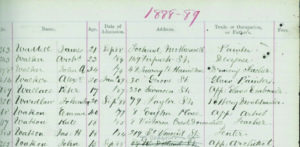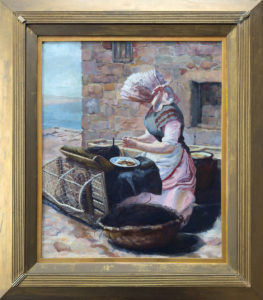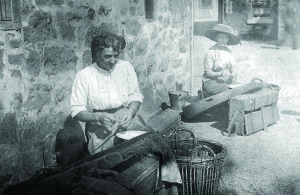Judith Booth from the Coastal Communities Museum in North Berwick, East Lothian has kindly written a blog about Catherine Watson, a former GSA student who gave her life to save three drowning children off the North Berwick coastline in 1889. An exhibition to commemorate Catherine was opened at the Museum last year and has been extended to this year.
The granite cross on Anchor Green is a familiar sight in North Berwick. It has become part of the landscape near the harbour – commonly assumed to be a war memorial. It is, in fact, a tribute to a brave young woman from Glasgow who attended The Glasgow School of Art called Catherine Watson.

Catherine Watson Memorial, North Berwick © ELMS
On Saturday 27 July 1889, Catherine Watson was dressing after swimming in the sea off North Berwick’s East Beach when she saw two boys and a girl being swept away by the tide. Kate, as she was known to her family and friends, immediately ran back to the water’s edge:
“Without hesitation, and simply with the clothes she had on, she hastened into the water. I saw her, quietly but determinedly, making her way through what was really an angry sea towards the boy who was nearest the shore. Having satisfied herself of his safety, she boldly struck out for the lad who …. was evidently in the greatest danger. I saw her as on the crest of a wave she got close to the object of her search, and then she seemed as if giving help, for the faces of both were distinctly turned towards the shore ….. This lasted, but for a short time, and then I was persuaded the two were separated, and I never saw them both again. It seems to me that this bold, generous-hearted, noble girl felt at the moment that her brave deed was done, that her strength was giving way, and that, at the moment many of us thought that all was well, she was yielding to the merciless waves.” Eye Witness, Haddingtonshire Courier, 2 August 1889
I saw Catherine’s work by chance on the BBC Antiques Roadshow in 2022. The North Berwick harbour setting caught my eye and I was excited to make the connection with our memorial cross on Anchor Green. Although I knew from the cross inscription that she had attended The Glasgow School of Art, her work was unknown. I was inspired to find out more about her life, her artistic background and to bring her story to the Coastal Communities Museum here in North Berwick. I spent a day at The Glasgow School of Art Archives searching for clues to Catherine’s time there.
Catherine Watson was born on 17 November 1869, the third daughter of Henry Watson, a shipping merchant and Catherine Watson of 8 Victoria Crescent, Dowanhill, Glasgow. She attended The Glasgow School of Art from 1885 until her untimely death in 1889. She won prizes in national and local competitions, winning a first class award for life drawing. During her time there she was listed as a student and latterly as a teacher:

Student Register, The Glasgow School of Art © The Glasgow School of Art.
Student contemporaries of Catherine’s at The Glasgow School of Art in the late nineteenth century included the architect and designer Charles Rennie Mackintosh and Jessie Keppie, artist and suffragist. The Glasgow School of Art’s director Francis Newbery, an artist and progressive educator, championed female artists and encouraged their attendance at the school.
A bronze relief panel designed in The Glasgow Style by Gertrude Isaacs, a friend and fellow student from the School of Art is positioned in the lower section of Catherine’s memorial cross. The inscription reads: “Kate Watson, a loving tribute from her fellow students of The Glasgow School of Art. The work of one of their number.”

Bronze relief memorial panel designed by Gertrude Isaacs, a student at The Glasgow School of Art, 1889. © Judith Booth

Untitled, (Woman baiting the ‘sma’ lines’) Oil on Canvas, Catherine Watson 1869-1889 © Dr Chris Bennett
Catherine’s stunning oil painting creates a vivid impression of working life at North Berwick harbour. The subject is wearing an ‘Ugli’ hat. These were handmade and protected against sun and wind and were unique to East Lothian. Baiting the ‘sma’ lines was time consuming work, usually carried out by female members of the household before the fishing boats set sail. Mussels were meticulously fixed to up to 1200 hooks attached to lengths of rope. Once the bait was attached to the hooks, they would be laid in rows inside a ‘scull’ between layers of grass to avoid tangling.
The Kelly family fished in North Berwick for generations. Elizabeth Kelly is pictured baiting the fishing lines at the same location in the Lower Quay as Catherine’s painting, unchanged and still recognisable today:

Elizabeth Kelly, Lower Quay, North Berwick, circa 1920 © Karen Kelly
Our display about Catherine’s life and artistic work launched on the anniversary of her death in July last year and runs until the close of the season in October this year, with a very special set of exhibits on loan from her family descendants.
The museum can be visited at Coastal Communities Museum, School Road, North Berwick EH39 4JU, and will be open from Wednesday 3 April until Saturday 26 October 2024. Catherine’s story and artwork can also be viewed on our website: www.coastalmuseum.org.

